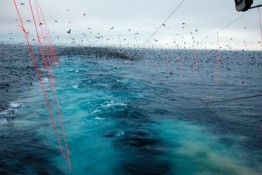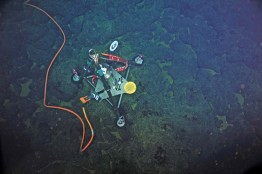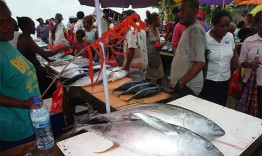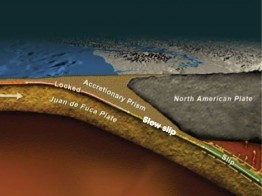A Washington Sea Grant staff scientist is sharing top honors for developing gear that nearly eliminates seabird bycatch in long-line fisheries from the West Coast to South Africa. Twenty years of work on sea and land to save threatened seabirds from becoming fishing bycatch have won national recognition for senior fisheries scientist, Ed Melvin, also an affiliate associate professor in the UW School of Aquatic and Fishery Sciences.
Read more at UW Today »Seafloor sensors record possible eruption of underwater volcano
Thanks to a set of high-tech instruments installed last summer by a team of scientists, many at the College of the Environment, the deep sea is online and scientists were able to observe the eruption of the Axial Volcano on April 23. About 300 miles offshore from Astoria, Oregon, and one mile deep, the data collected flowed back to the land at the speed of light through fiber optic cable.
Read more at UW Today »Sustainability progress should precede seafood market access, researchers urge
A team of researchers, including Edward Allison from the College of the Environment’s School of Marine and Environmental Affairs, has evaluated fishery improvement projects designed to bring seafood from wild fisheries to the certified market while promising sustainability in the future. In a policy paper appearing May 1 in Science, the team concluded that these projects need to be fine tuned to ensure that fisheries are delivering on their promises.
Read more at UW Today »Exploring Earth's final frontier
Covering more than 70 percent of Earth’s surface, the oceans act as our planet’s heartbeat, with differences in depths, currents, temperature and salinity marking changes in its pulse. While these measurements are fairly straightforward, the information they relay about Earth’s health is much more complex. As the planet warms, much of the heat is absorbed in the oceans, resulting in rising sea levels and changes to how water mixes and currents move.
Read more on the UW homepage »Tidal tugs on Teflon faults drive slow-slipping earthquakes
Unknown to most people, the Pacific Northwest experiences a magnitude-6.6 earthquake about once a year. The reason nobody notices is that the movement happens slowly and deep underground, in a part of the fault whose behavior, known as slow-slip, was only recently discovered. A University of Washington seismologist who studies slow-slip quakes has looked at how they respond to tidal forces from celestial bodies and used the result to make a first direct calculation of friction deep on the fault.
Read more at UW Today »





